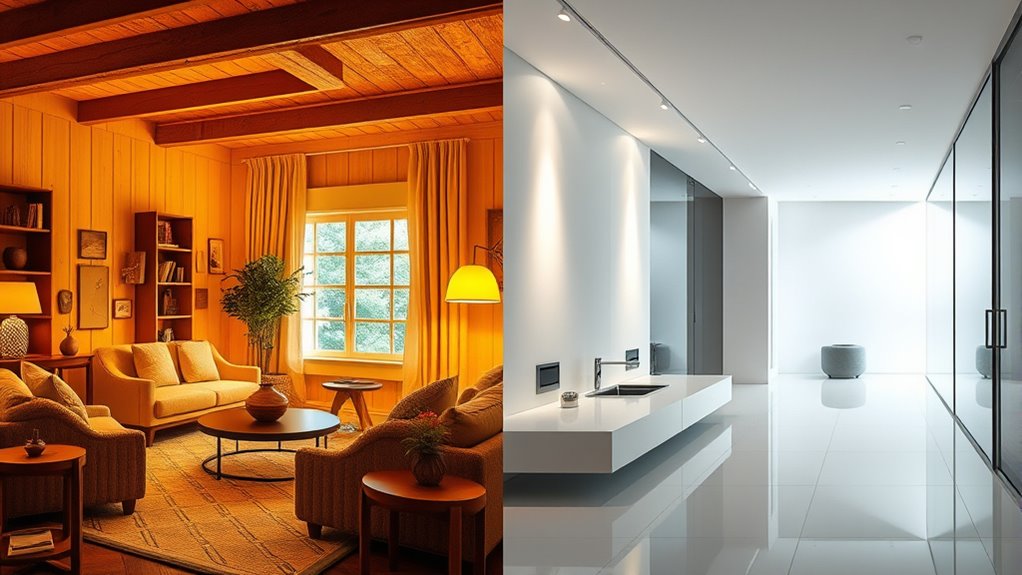Choosing between warm whites and cool whites depends on your space’s purpose and mood. Use warm whites (2700K–3000K) in areas where you want a cozy, inviting feel, like living rooms or bedrooms, to create comfort and relaxation. Opt for cool whites (3500K–5000K) in workspaces or kitchens to boost alertness and clarity. Considering these tips can help you set the perfect atmosphere—if you keep exploring, you’ll discover even more about choosing the right lighting.
Key Takeaways
- Use warm whites (2700K-3000K) in living rooms, bedrooms, and dining areas to create a cozy, inviting atmosphere.
- Choose cool whites (3500K-5000K) for kitchens, bathrooms, and workspaces to enhance brightness and focus.
- Warm whites complement earthy tones and soft furnishings, fostering relaxation and comfort.
- Cool whites emphasize cleanliness, modernity, and are ideal for minimalistic or industrial interior styles.
- Decide based on desired ambiance: warmth and intimacy or clarity and productivity.

Choosing the right white light can considerably impact the mood and appearance of a space. When it comes to selecting white light for your home or office, understanding the nuances of color temperature is fundamental. Warm whites tend to have a lower color temperature, usually between 2700K and 3000K, giving off a cozy, inviting glow. Cool whites, on the other hand, have a higher color temperature, typically ranging from 3500K to 5000K, offering a bright, crisp illumination. Your choice of white light directly influences the overall interior design and how you perceive your environment.
Choosing the right white light sets the mood and enhances your space’s design.
If you’re aiming for a space that feels welcoming and relaxed, warm whites are your best bet. They enhance comfort and create an intimate atmosphere, making them ideal for living rooms, bedrooms, and dining areas. Warm whites complement earthy tones and soft furnishings, adding a layer of warmth that makes a space feel more personal and inviting. When selecting lighting for these areas, consider warm whites to foster a sense of coziness and relaxation. Their gentle glow also reduces eye strain in the evening, helping you unwind after a long day.
Conversely, cool whites excel in settings where clarity and focus matter. Their higher color temperature mimics natural daylight, which can boost alertness and productivity. This makes them perfect for kitchens, bathrooms, and workspaces. Cool whites emphasize crispness and cleanliness, highlighting details and textures in your interior design. If you want your space to feel more modern and energetic, opt for cool white lighting. It also works well in environments that require accurate color rendering, such as art studios or craft rooms, where seeing true colors is vital.
It’s important to think about how each type of white light interacts with your decor and furniture. Warm whites tend to soften the look of wood and warm-colored walls, creating harmony. Cool whites, however, accentuate clean lines and contemporary styles, especially in minimalist or industrial settings. Think about the mood you want to establish and how each color temperature will complement your existing interior design. For example, a cozy reading nook benefits from warm whites, while a sleek kitchen or office might be better suited to cool whites.
Additionally, understanding color temperature can help you make more informed lighting choices that align with your desired ambiance and functional needs. Ultimately, the choice between warm and cool whites hinges on your intended atmosphere and functional needs. By understanding the significance of color temperature and how it influences interior design, you can select lighting that enhances your space’s aesthetic and mood. Whether you want a tranquil retreat or an energizing workspace, picking the right white light guarantees your environment feels just right.
Frequently Asked Questions
How Do Warm and Cool Whites Impact Room Mood?
Warm whites create a cozy, inviting emotional atmosphere with their softer, yellowish hue, making you feel relaxed and comfortable. Cool whites, with their higher color temperature, generate a bright, energizing mood perfect for focus and productivity. By choosing warm or cool whites, you control the emotional atmosphere in your space, either fostering warmth and intimacy or promoting alertness and clarity.
Can Warm Whites Make a Space Feel Smaller?
Think of warm whites as a cozy blanket that can sometimes shrink a room’s feel, like a shrinking castle in a storybook. Warm whites influence color perception, making spaces appear more intimate and snug, which can reduce visual expansion. So, if you want a room to feel larger, stick with cooler whites. But if you crave warmth and coziness, warm whites will make your space inviting, even if it feels a bit smaller.
Are There Specific Paint Brands Known for Warm or Cool Whites?
You’ll find that popular paint brands like Benjamin Moore, Sherwin-Williams, and Behr offer excellent warm and cool white options. For warm whites, try Benjamin Moore’s Simply White or Sherwin-Williams’ Alabaster. If you prefer cool whites, consider Behr’s Polar Bear or Sherwin-Williams’ Extra White. These brands provide a variety of color palette options, making it easier to select the perfect shade for your space.
How Do Lighting Conditions Influence the Appearance of White Shades?
Lighting effects can make or break how you perceive white shades. When the light is warm or dim, it can cast a yellowish hue, making cool whites look dull. Bright, natural light enhances the true color perception of white shades, revealing their crispness. You’ll want to take into account your space’s lighting to choose the right white, as it’s often said, “the proof is in the pudding”—lighting truly shows the color’s true face.
Can Warm and Cool Whites Be Combined Effectively in One Space?
Yes, you can combine warm and cool whites effectively in one space. Focus on color blending to create a seamless progression, choosing shades with similar undertones or complementary hues. This approach enhances design harmony, making the room feel cohesive and balanced. Use warm whites for cozy areas and cool whites for modern, fresh spaces. Proper lighting and strategic placement help unify the different shades, resulting in a harmonious, inviting environment.
Conclusion
Think of warm whites as a cozy campfire, inviting you to unwind and feel at home, while cool whites are like a crisp mountain stream, energizing and clear. Choosing between them is like selecting the right path in a forest—warm for comfort, cool for focus. By understanding their roles, you’ll navigate your lighting choices with confidence, creating spaces that truly reflect your mood and purpose. Let your lighting be the guiding star in your design journey.









